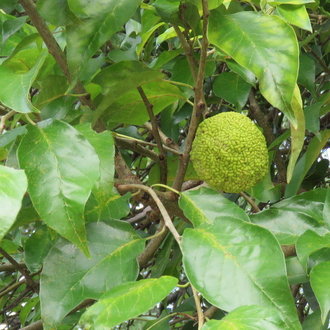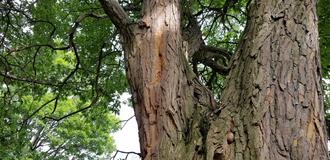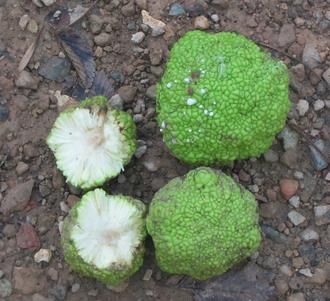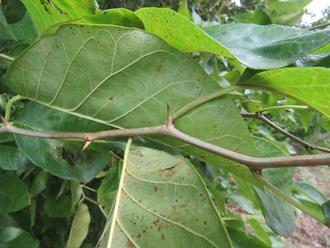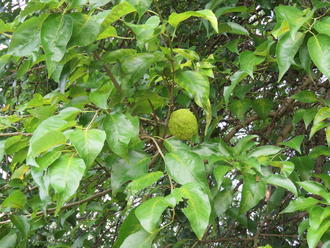Osage-orange (Maclura pomifera (Raf.) C.K. Schneid.)
Also known as Osage orange, hedge apple.
↑Summary
A small and somewhat peculiar tree with bright orange bark, long thorns on stems, and producing large compound fruits which are hard and have a distinct aroma.
↑Range - Expand
| Legend | Color |
| Native | |
| Expanded | |
| Native or Expanded | |
| Expanded or Not Present |
This map is based on our research. We have checked its accuracy to Level 3 ecoregions. Although this plant occurs somewhere in each of these regions, it may only occur in a small part of some or all of them.
Defining native on the basis of range at the time of European settlement, this species had only a small native range. However, fossil evidence suggests this species once range broadly across the continent. In modern times, humans have both widely planted this species, and cleared bottomland areas, thus creating new habitat for it, leading it to greatly expand again.
↑Habitat
Prefers full to partial sun, and any soils except acidic soils. Prefers moist sites, but also drought tolerant. Tolerates air pollution. Able to survive very cold areas, far north of its native range, suggesting it may have once been more widely distributed.
Found in floodplain forests, thickets, savannas, overgrown borders in rural areas, and open, degraded woodlands. Particularly common in small fragments of forest, and uncommon in larger, unbroken tracts of forest.
Although this plant can grow in a range of conditions, it is usually only found near humans, where people have either planted it nearby, or disturbed the habitat in a way that it benefits from. Given the present ecological factors in North America, this species probably would not persist indefinitely in the wild in the absence of human intervention.
↑Life Cycle
Seeds germinate in exposed mineral soil and direct sunlight.
Growth is rapid, averaging over one foot per year in the first several years. Female trees begin producing seed around 10 years of age, but seed production is lower until around 25 years of age, and good seed production continues until about 65 years. Seed production is consistent from year to year.
Plants are able to reproduce vegetatively relatively easily, including both from root sprouts and by layering of branches, but the extent to which this occurs in the wild is not well-known. Plants resprout vigorously if top-killed.
The overall lifespan is relatively short for a hardwood; we have seen it described as short as 75 years and as long as 130.
↑Faunal Associations
This plant has been theorized to be associated with now-extinct megafauna of North America, which may have distributed its fruit.
The thorns are used by shrikes (Laniidae sp.) to impale their prey.
↑Uses
The Osage-orange is used as a windbreak, due to its ability to withstand exposed conditions, as well as the ease of propagation by rooting its branches to grow into new shrubs. Its thorns also made it attractive as fencing for cattle, before the advent of barbed wire.
The wood has good properties but frequently grows in twisted, irregular shapes, limiting its usefulness to smaller applications, such as fenceposts, for which it is widely used.
The firewood has a high heat content.
The fruit are sometimes used for their supposed ability to repel insects and spiders in the home.
↑Related Plants
There are several other Maclura species worldwide. One, the Mandarin melon berry (Maclura tricuspidata), native to East Asia, has been introduced at a few scattered locations in the southeast.
There are numerous other species in North America, both native and introduced, in the broader Moraceae, or mulberry or fig family.
↑Notes
Although named "orange", it is not closely related to oranges; the resemblance is superficial, due to similar leaf shape and both species having fairly long thorns on their twigs.
↑Links & External Resources
• Osage Orange | The Wood Database (About This Site)
• Osage-Orange | Fire Effects Information System (FEIS) (About This Site)
• Maclura pomifera (Osage Orange) | Illinois Wildflowers (About This Site)
• Maclura pomifera (Osage-orange) | USDA PLANTS Database (About This Site)
• Maclura pomifera | Go Botany (About This Site)
• Maclura pomifera (Osage Orange) | Missouri Botanical Garden Plant Finder (About This Site)
• Osage-Orange | Virginia Tech Dendrology Factsheets (About This Site)
• Osage-Orange | Silvics of North America (About This Site)
• Maclura pomifera | Biota of North America Project (BONAP) (About This Site)
• Maclura pomifera | NatureServe Explorer (About This Site)
• Maclura pomifera | Flora of North America (About This Site)
• Osage Orange | Maryland Biodiversity Project (About This Site)
• Maclura pomifera (Raf.) Schneid. (Osage Orange, Hedge Apple, Bois-d'arc) | Digital Atlas of the Virginia Flora (About This Site)



